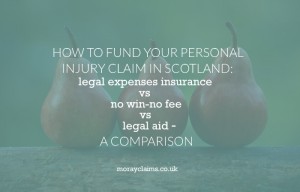If you consult a solicitor about a possible personal injury claim, you will have a lot of questions. Common examples would be: How much is my claim likely to be worth? How long will it take? But the most important question of all is probably: do I have a claim at all? Lawyers will decide the answer to that on the basis of whether reasonable prospects of success exist. It usually boils down to whether your claim has a better than 50/50 chance of succeeding. So, if the most important question is "Do you think I have a claim?", your solicitor will be keen to reach a view on that issue as quickly as possible. In many situations, your solicitor can reach a provisional view on your prospects of success immediately. They can often give you advice on your chances, just on the initial information you give them. If you’ve been injured in a road traffic accident where another vehicle ran into the back of yours, it was probably their fault. You were on the main road Continue Reading
A Comparison Of Personal Injury Claim Funding Methods: No Win-No Fee vs Legal Aid vs Legal Expenses Insurance
In theory, you could run your Personal Injury Claim on a private fee-paying basis. You would have to pay your solicitor interim fees as the case progressed. You would have to pay for all outlays, including recovery of medical records and payment of expert witness fees. If your case went to Court, you would have to bear a hefty risk. Lose your case and you will not only have to pay the fees and outlays of your own solicitor; you will also be responsible for paying the fees and outlays of the opposing solicitor. Depending upon the complexity of the case and which Court any action is raised in, your legal bill would certainly be thousands of pounds and might be tens of thousands of pounds. Unless you have bottomless financial resources (in much the way that insurance companies do) private fee paying arrangements for personal injury claims are generally reckoned to be “a bad idea”. You need to be able to run your claim in a way which costs a lot less and carries a lot less Continue Reading
If You Are Off Work After An Accident What Rights Do You Have To Receive Pay (or other benefits)?
The Telegraph newspaper reported in January 2014 about a doctor at Barts Hospital in London who had erroneously received a “banding supplement” of £4,000 per month for on-call duties. This went on for more than two-and-a-half years, with the incorrect payments totalling £126,000. Overpayments of wages can occur in a variety of ways, including genuine payroll errors and miscalculation of commission/bonus schemes. According to the report, the £126,000 mistake (which was the most expensive of many) was to be resolved by the doctor paying it back at £500 per month. That would take over 21 years. While overpayments of wages can and do occur (as seen above), where you’ve been injured and are off your work as a result, you’re much more likely to be experiencing an underpayment of wages. The negative financial consequences of being injured in an accident can be significant. What steps can you take to make sure you maximise your income in the aftermath of an accident which leaves you Continue Reading
The Most Popular Personal Injury Articles On The Moray Claims Website In 2016
In 1985, in Camden, London, a graffiti artist known as “King Robbo” spray-painted his name – in yellow, red and black – on a tunnel wall. Photographed in 2006, it can be seen that Robbo’s original had gradually faded to form the background of other graffiti scrawled on top. The well-known, though anonymous, street artist, Banksy, enters the story in 2009. He partially obliterated Robbo’s wall with an image of a workman “wallpapering” over the graffiti in plain grey. Only the “bo” of “Robbo” remained visible. Robbo’s retaliation – on Christmas Day 2009 – was to complete the greywash of his original image. Leaving Banksy’s image of the workman, with his can and paint brush, in place, Robbo added the words “KING ROBBO”, making it appear that the workman had put them there. As the dispute moved into 2010, Banksy heated things up with his reply - adding “FUC” in front of “KING”. With hindsight, it was almost as if Robbo had invited that addition. Robbo seems to have edited it Continue Reading



